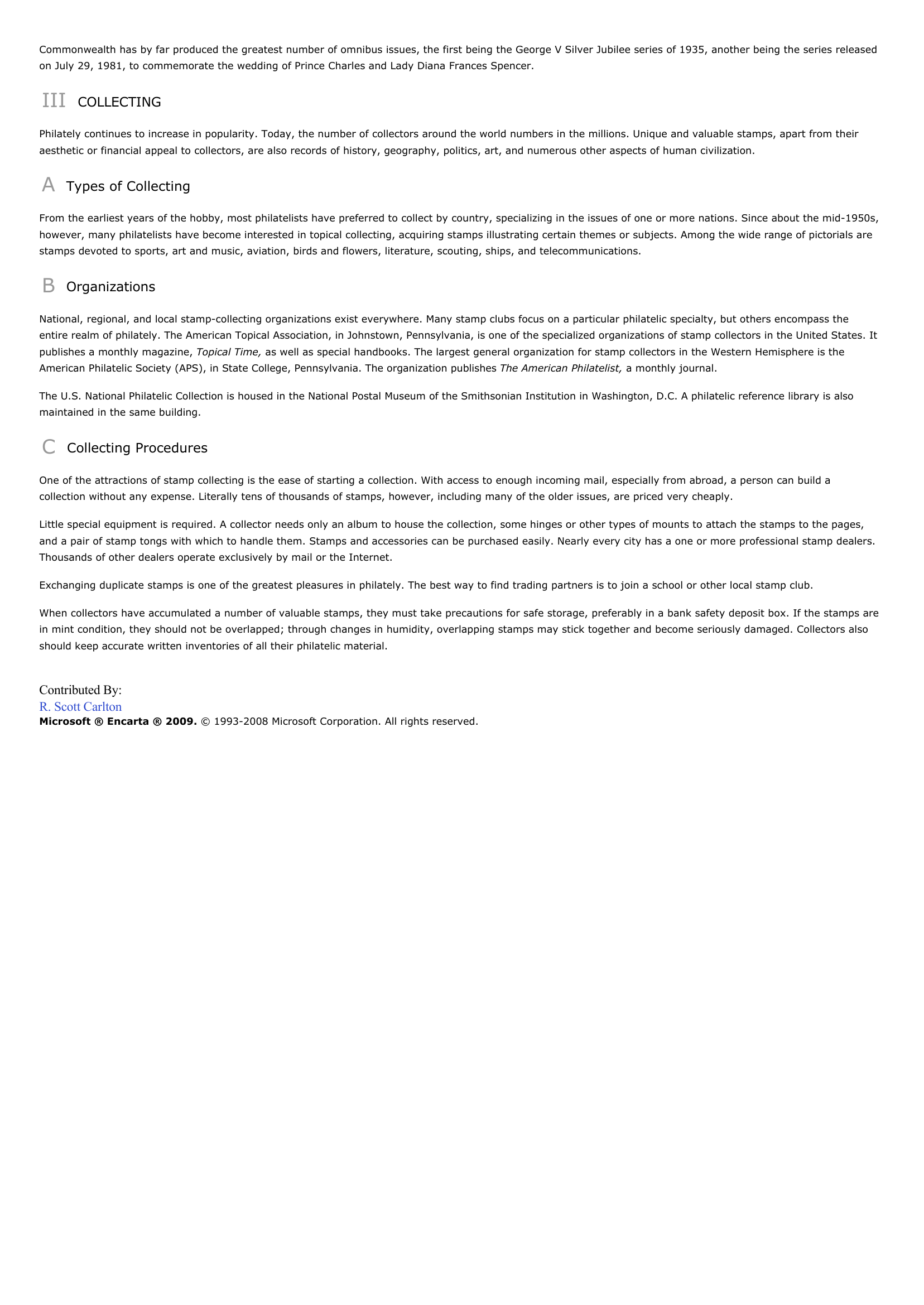Stamps and Stamp Collecting.
Publié le 14/05/2013

Extrait du document
«
Commonwealth has by far produced the greatest number of omnibus issues, the first being the George V Silver Jubilee series of 1935, another being the series releasedon July 29, 1981, to commemorate the wedding of Prince Charles and Lady Diana Frances Spencer.
III COLLECTING
Philately continues to increase in popularity.
Today, the number of collectors around the world numbers in the millions.
Unique and valuable stamps, apart from theiraesthetic or financial appeal to collectors, are also records of history, geography, politics, art, and numerous other aspects of human civilization.
A Types of Collecting
From the earliest years of the hobby, most philatelists have preferred to collect by country, specializing in the issues of one or more nations.
Since about the mid-1950s,however, many philatelists have become interested in topical collecting, acquiring stamps illustrating certain themes or subjects.
Among the wide range of pictorials arestamps devoted to sports, art and music, aviation, birds and flowers, literature, scouting, ships, and telecommunications.
B Organizations
National, regional, and local stamp-collecting organizations exist everywhere.
Many stamp clubs focus on a particular philatelic specialty, but others encompass theentire realm of philately.
The American Topical Association, in Johnstown, Pennsylvania, is one of the specialized organizations of stamp collectors in the United States.
Itpublishes a monthly magazine, Topical Time, as well as special handbooks.
The largest general organization for stamp collectors in the Western Hemisphere is the American Philatelic Society (APS), in State College, Pennsylvania.
The organization publishes The American Philatelist, a monthly journal.
The U.S.
National Philatelic Collection is housed in the National Postal Museum of the Smithsonian Institution in Washington, D.C.
A philatelic reference library is alsomaintained in the same building.
C Collecting Procedures
One of the attractions of stamp collecting is the ease of starting a collection.
With access to enough incoming mail, especially from abroad, a person can build acollection without any expense.
Literally tens of thousands of stamps, however, including many of the older issues, are priced very cheaply.
Little special equipment is required.
A collector needs only an album to house the collection, some hinges or other types of mounts to attach the stamps to the pages,and a pair of stamp tongs with which to handle them.
Stamps and accessories can be purchased easily.
Nearly every city has a one or more professional stamp dealers.Thousands of other dealers operate exclusively by mail or the Internet.
Exchanging duplicate stamps is one of the greatest pleasures in philately.
The best way to find trading partners is to join a school or other local stamp club.
When collectors have accumulated a number of valuable stamps, they must take precautions for safe storage, preferably in a bank safety deposit box.
If the stamps arein mint condition, they should not be overlapped; through changes in humidity, overlapping stamps may stick together and become seriously damaged.
Collectors alsoshould keep accurate written inventories of all their philatelic material.
Contributed By:R.
Scott CarltonMicrosoft ® Encarta ® 2009. © 1993-2008 Microsoft Corporation.
All rights reserved..
»
↓↓↓ APERÇU DU DOCUMENT ↓↓↓
Liens utiles
- Collectibles and Collecting.
- Coins and Coin Collecting.
- Ideology and Rationality in the History of the Life Sciences
- Relationship between religion, spirituality, and young Lebanese university students’ well-being.
- Course of reading and writing for 1st year English Licence





